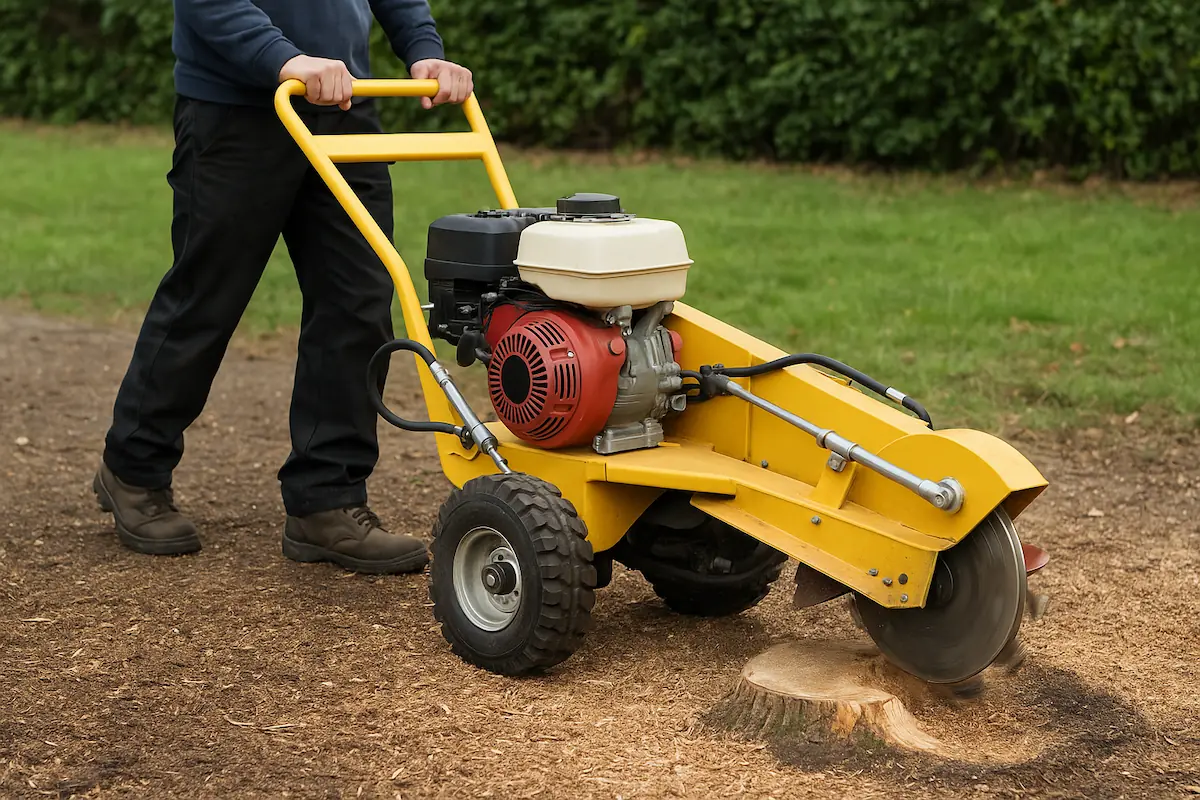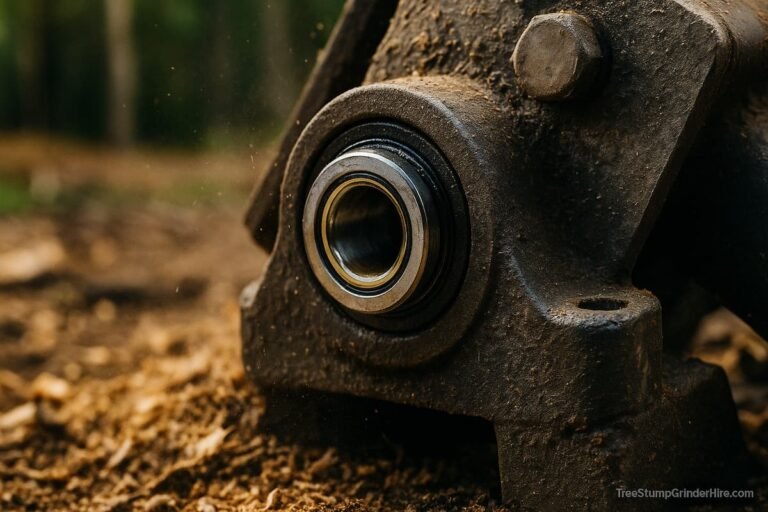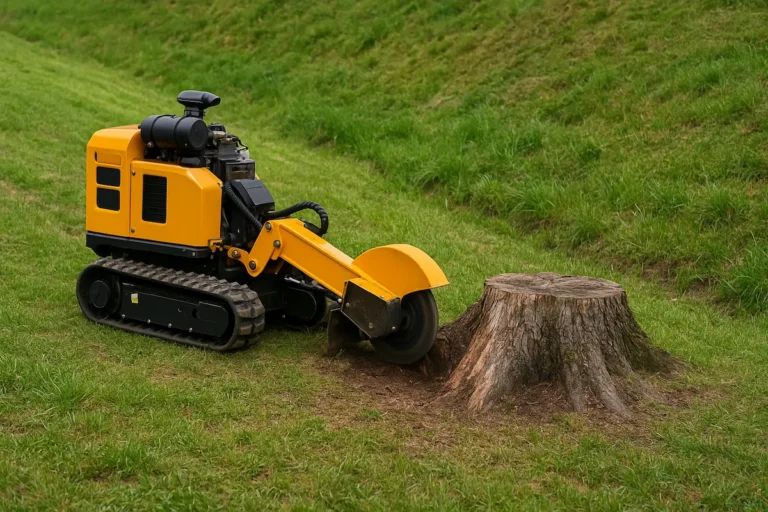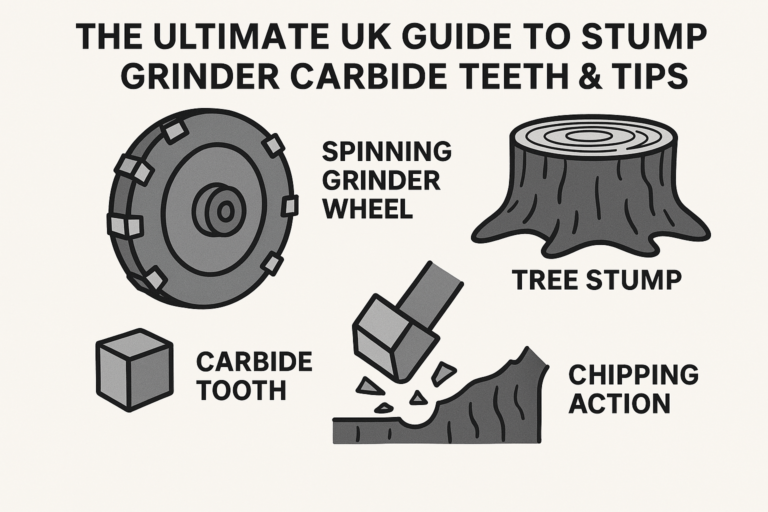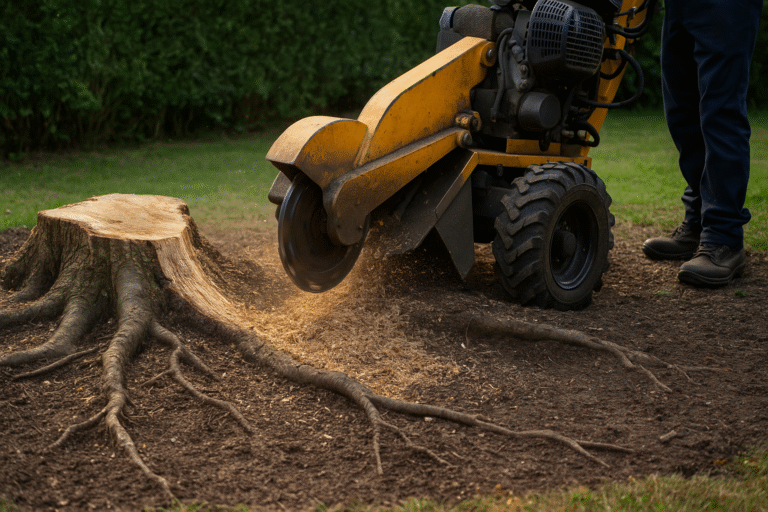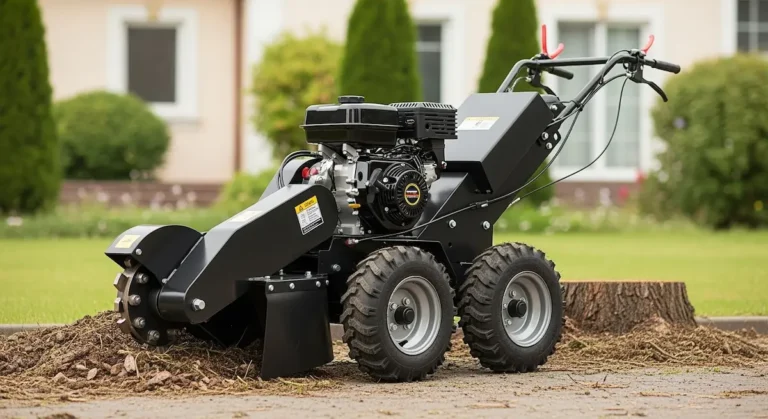What is a Stump Grinder Swing Cylinder & Why It Matters for Your Hire
A stump grinder’s swing cylinder helps move the cutting wheel side to side.
It is an essential part of grinding stumps quickly and easily.
Key Takeaways: Stump Grinder Swing Cylinder Issues
- The chart highlights the common problems associated with stump grinder swing cylinders, as discussed in the article.
- Hydraulic fluid leaks and jerky or stuttering swing motion are frequently mentioned concerns, indicating potential wear or fluid issues.
- Slow swing, head drifting (not holding position), and complete failure to swing are other significant problems hirers should watch for.
- These issues directly impact grinding efficiency, control, and safety.
- Promptly reporting any of these symptoms to the hire company (like TreeStumpGrinderHire.com) is crucial for safety and machine reliability.
Understanding the Swing Cylinder on a Stump Grinder
The swing cylinder is a strong metal tube near the grinder’s main body, close to where the cutting wheel arm pivots.
It uses special oil pressure, called hydraulics, to work.
Think of it like a strong arm that pushes and pulls the cutting wheel assembly left and right.
This movement lets you sweep the sharp cutting teeth across the entire face of the stump.
It resembles how power steering helps turn a car’s wheels easily.
The swing cylinder provides controlled power for this sideways motion.
Without it, moving the heavy cutting head accurately would be very hard.
Why a Smooth Swing Cylinder Means Easier Stump Grinding
A good swing cylinder makes your stump grinding job much faster.
It allows the cutting wheel to move smoothly and steadily across the wood.
You can make even passes, like mowing a lawn, stripe by stripe.
This grinds the stump down layer by layer without missing spots.
Imagine trying to paint a wall with a brush that keeps sticking or jumping.
It would be slow, messy, and frustrating.
A faulty swing cylinder can make the grinder act like that sticky brush.
Jerky or slow movements waste your time and effort.
It can make controlling the stump grinder feel difficult.
You might have to go over the same area multiple times.
This uses more fuel and takes longer to finish the job.
We want your hiring experience to be easy and efficient.
A reliable swing cylinder means you get the job done quicker, with less hassle.
It helps you achieve a clean, level finish where the stump used to be.
This direct control makes the process more manageable, even for first-time users.
“I hired a grinder last year from somewhere else, and the controls were so sticky, it took ages. The one from TreeStumpGrinderHire.com was much smoother but felt like a different machine!” – Common feedback reflecting user experience.
How the Swing Cylinder Works: Simple Hydraulics
The swing cylinder uses hydraulic power.
Hydraulics use special oil pushed under pressure to make things move.
Inside the cylinder is a rod that can slide in and out.
When you move the control lever for swinging left, hydraulic oil is pumped into one side of the cylinder.
Depending on design, this pressure pushes the rod out (or pulls it in).
This movement pushes or pulls the arm holding the cutting wheel, making it swing left.
When you move the lever to swing right, oil is pumped into the other side.
This reverses the pressure and moves the rod, swinging the cutting head right.
The control levers give you precise command over this movement.
You decide the speed and direction of the swing.
It is a simple but powerful system used in lots of heavy machinery.
This system needs clean hydraulic oil and good seals to work correctly.
Leaks or dirty oil can cause problems with the swing action.
Think of it as the brakes on a bike needing good Fluid in the lines.
Finding the Swing Cylinder on Your Hired Grinder
The swing cylinder is quite visible on most stump grinders you can hire.
Look near the pivot point where the main cutting arm connects to the grinder’s body.
You will likely see one or two metal cylinders with hydraulic hoses connected.
These are responsible for the side-to-side swing.
They might be positioned horizontally or slightly angled.
Our team can point it out during your hire briefing if unsure.
Knowing where it is helps you spot any obvious issues, like leaks.
Smooth Operation vs. Potential Problems
A well-working swing cylinder feels responsive.
When you move the control lever, the cutting head swings smoothly.
The speed matches how much you move the lever.
It stops promptly when you centre the control.
The movement should be consistent and predictable.
But sometimes, things can go wrong, especially on heavily used machines.
Knowing what to look for helps you identify issues early.
Reporting problems quickly ensures your safety and helps us fix them.
Common Problems Summary Box
- Leaks: Wetness or dripping oil around the cylinder or hoses.
- Jerky Swing: Uneven, stuttering movement instead of a smooth sweep.
- Slow Swing: Movement is much slower than expected or usual.
- Drifting: Cutting head moves sideways, even with untouched controls.
- No Swing: The cutting head refuses to move side-to-side at all.
Spotting Swing Cylinder Issues: What a Hirer Should Report
You do not need to be a mechanic, but noticing these signs is helpful.
Your safety and a good working machine are our priorities.
Obvious Hydraulic Fluid Leaks
Look around the swing cylinder body and the hose connections.
Are wet patches, oil drips, or a small puddle forming underneath?
Hydraulic oil is usually amber or reddish.
Significant leaks are serious. They mean the system is losing pressure.
This can make the swing weak, slow, or stop working altogether.
Low hydraulic Fluid can damage other parts of the machine.
What to do: Stop using the machine immediately. Call us to report the leak. Do not try to tighten connections yourself unless instructed.
Case Study Snippet (from Forum Data): A user described their hired grinder as slow. They later found a small, steady drip from a hose fitting near the swing cylinder and reporting it allowed the hire company to fix the minor leak before it caused major issues.
Jerky, Stuttering, or Unusually Slow Swing
Does the cutting head jump or stutter as it moves sideways?
Does it feel like it is fighting you or moving much slower than before?
This can make precise grinding very difficult and frustrating.
It might indicate problems inside the cylinder, like worn seals.
It could also be related to low hydraulic Fluid (perhaps from an unnoticed leak).
Sometimes, air trapped in the hydraulic lines can cause jerky movements.
What to do: Note how it feels. Is it jerky in one direction or both? Is it always slow, or only sometimes?
Grinding Head ‘Drifting’ or Not Holding Position
You finish a swing pass and centre the control lever.
Does the cutting head slowly continue to move sideways on its own?
This is called ‘drifting’ or ‘creeping’.
This means that the cylinder is not holding its position firmly.
Internal leaks within the swing cylinder itself often cause this.
The hydraulic Fluid slowly bypasses the piston seals inside.
Drifting makes accurate grinding very hard.
You constantly have to correct the cutting head’s position.
What to do: Report this symptom. Explain that the head moves when the controls are neutral. This helps us pinpoint the likely internal issue.
Complete Failure to Swing
You move the swing control lever, but nothing happens.
The cutting head will not move left or right at all.
This could be a major hydraulic issue.
It might be the cylinder, control valve, or hydraulic pump.
There might be a blockage or a major component failure.
What to do: Stop work immediately. Check that the machine’s engine is running and hydraulics are engaged (if applicable). If it still won’t swing, call us straight away.
Tips for Smooth Swing Control During Your Hire
Using the swing controls effectively makes the job easier.
- Be Smooth: Use steady, deliberate movements on the control levers. Avoid harsh, jerky inputs back and forth.
- Control the Speed: Adjust the lever gently to control the swing speed. Faster is not always better; a controlled sweep is more efficient.
- Overlap Your Passes: As you swing across the stump, overlap each pass slightly. This ensures you grind the entire surface evenly. Think of colouring in a shape without leaving white gaps.
- Listen to the Machine: Pay attention to the engine sound. You might swing too fast or cut too deeply if it bogs down heavily during a swing. Ease off slightly.
- Read the Manual: Always follow the specific operating instructions provided with your hired stump grinder. Controls can vary slightly between models.
“I found that moving the swing lever slowly gave me much better control, especially on the tougher parts of the stump.” – Advice is often shared among experienced users.
Our Promise: Reliable Swing Cylinders Through Good Maintenance
At TreeStumpGrinderHire.com, we know reliable equipment is crucial.
A breakdown wastes your valuable time and causes frustration.
The hydraulic system, including the swing cylinder, gets regular checks.
We want every hirer to have a smooth, trouble-free experience.
Key Hydraulic Checks We Perform
We perform regular checks on the hydraulic systems of our grinders. This includes:
- Checking Fluid Levels: Ensuring the hydraulic oil is at the correct level. Low Fluid causes poor performance and damage.
- Inspecting Fluid Condition: Looking for signs of contamination (dirt, water) or fluid breakdown. Dirty oil wears out components faster. We change Fluid at recommended intervals.
- Scanning for Leaks: Carefully inspecting all cylinders, hoses, and fittings for any signs of hydraulic fluid leaks, big or small.
- Testing Cylinder Operation: Actuating the swing cylinder (and other hydraulic functions like lift/lower) to ensure smooth, responsive movement. We listen for unusual noises and watch for jerky motion or drifting.
- Hose Condition Checks: Examining hydraulic hoses for cracks, bulges, rubbing, or other signs of wear that could lead to failure.
Why This Matters: These checks mean the stump grinder you hire is less likely to have hydraulic issues. It translates to reliable performance during your job.
Table: Example Maintenance Focus Areas
| Component Checked | What We Look For | Why It’s Important for Hirer |
|---|---|---|
| Swing Cylinder | Leaks, smooth rod, responsiveness | Ensures easy, controlled side-to-side movement |
| Hydraulic Hoses | Cracks, bulges, leaks, secure fit | Prevents sudden failures, maintains pressure |
| Hydraulic Fluid | Correct level, cleanliness | Powers the system, prevents component wear |
| Control Levers | Smooth operation, proper function | Allows precise command over grinder actions |
| Hydraulic Pump | Correct pressure, no unusual noise | Provides the power for all hydraulic parts |
Note: This is a simplified overview of our detailed maintenance schedules.
Benefits of Well-Maintained Swing Cylinders for Your Hire
Choosing TreeStumpGrinderHire.com means choosing reliability. A well-maintained swing cylinder directly benefits you:
- Faster Work: Smooth, predictable swings let you grind stumps much more quickly.
- Easier Control: The machine feels responsive and does what you command, reducing frustration.
- Less Effort: You won’t have to fight jerky controls or constantly correct drifting.
- Better Finish: Even passes lead to a neater, more level result where the stump was.
- Increased Confidence: Knowing the equipment is well-looked-after allows you to focus on the job safely.
- Reduced Downtime: Fewer breakdowns mean you can complete your project within your hire period.
Statistic Insight (Qualitative from Repair Data): Hydraulic system issues, including cylinder seal failures, are common reasons for downtime in heavily used stump grinders, according to repair forums and technician videos. Regular maintenance significantly reduces these occurrences.
Common Swing Cylinder Questions Answered
Q: Is seeing a tiny bit of oily dust around the cylinder normal?
A: While a completely dry cylinder is ideal, a slight ‘weep’, leaving an oily film (not drips), might occur on older seals. However, any actual wetness or dripping should be reported to us immediately. It is best to let us check it.
Q: Why is the swing suddenly really slow or weak?
A: This could be low hydraulic Fluid (check for leaks!), contaminated Fluid, a worn pump, or an issue with the cylinder or control valve. Could you stop using the machine and contact us? We need to diagnose the specific cause. Do not keep operating it as this could cause more damage.
Q: Can I fix a leaking swing cylinder on a hired machine?
A: No. Please do not attempt repairs on hire equipment. Hydraulic systems are under high pressure and require specific tools and knowledge. Report the issue to us, and we will handle the repair or provide a replacement machine. Your safety is paramount.
Safety First: Working with Hydraulic Machinery
Stump grinders are powerful tools. Hydraulic systems operate under high pressure.
Wear appropriate safety gear, including eye protection, gloves, and sturdy boots.
Read and understand all operating instructions provided with your hire.
Never place hands or feet near moving parts, including the swing cylinder area, while the machine runs.
Be aware of the swing area and keep bystanders at a safe distance.
Report any unusual noises or operational issues immediately.
TreeStumpGrinderHire.com prioritises safety information during handover.

